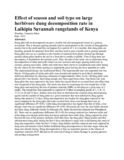| dc.description.abstract | Dung piles left un decomposed can pose a health risk and management issues in a grazing ecosystem. This is because grazing animals tend to reject pasture in the vicinity of dung patches mainly due to the smell and this can happen for a period of 3. to 4 months. Also dung piles are breeding grounds for parasites from flies and thus tend to pose a health risk to grazing animals. Dung piles also act as a medium in the transfer of nutrients from plants (locked up) through animals (dung piles) back to the soil in a form that is readily available. Thus if dung does not decompose, it destabilizes the nutrient cycle.
Thus, the aim of this study was to determine dung decomposition of zebra and cattle which are two common and major grazing herbivores in savanna grazing ecosystem. Zebra and cattle have been shown to complement each other during the dry season by the zebras grazing on unpalatable grass leaving the more palatable to cattle. The experimental design was randomized block. The experimental area was separated into two blocks. 80 dung piles of zebra and cattle were located and marked in each block, imitating herbivore defecation by allowing a diameter of approximately 20cm. In all, 160 dung piles were placed (80 x two blocks). Each dung sample was 50cm apart from other. One block was with dung piles that were exposed to the rains while the second block ws covered form rain effect thus was composed of dry dung piles.
The study was done by measuring the wet weight loss of the dung piles and analyzing the loss of primary nutrients (NPK) in the dung in a given time of 2 weeks. The weight loss was measured in a period of 33 days at sampling points of 1, 5, 9, 13, 17,21,25,29 and 33 days. Studies were also done to determine the common dung decomposing agents and the number of dung piles in a given treatment that were infested by dung agents during this period of 33 days. Dung decomposition was higher for dung piles exposed to the rains compared to the dung piles that were covered form rains even though there was no significant difference (P<0.05). Cattle dung decomposition was higher than that of zebra, even though, there was no significant difference (P<0.05).
Potassium (K) was the most labile element lost from dung, followed closely by Nitrogen (N), while the least lost element was Phosphorus (P). There was no significance difference (P<O.05) for average nutrient loss between cattle and zebra dung even though zebra dung lost more nutrients than cattle dung. Dung exposed to rains favored the loss of the primary elements (N,P &K) from the dung piles.
Dung beetles and flies infested most dung piles during the first 5 days and played a major role in facilitating the onset of dung decomposition. After the first 5ᄋ days, dung beetles and flies reduced and were replaced by dung ants and termites which further facilitated dung decomposition at the later stages when the dung was already drying. Dung decomposition is thus an important process in the release of important nutrients (N, P &K)and in the removal of dung to reduce damage to grazing pastures and grazing management. | en_US |

